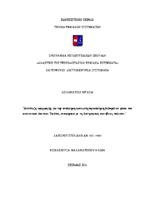Ανάπτυξη εφαρμογής για την ανάκτηση και κατηγοριοποίηση δεδομένων μέσω του κοινωνικού δικτύου Twitter, αναφορικά με τις διατροφικές συνήθειες πολιτών

View/
Keywords
Healthcare analytics ; Healthcare big data ; Machine learning algorithms ; Social media ; Big data technologiesAbstract
The healthcare industry is changing with incredible speed, and one of the major contributors to this change is the dramatic upsurge in healthcare communication brought on by social media. Not only has social media become a place where the public goes to seek health information, but by nature these social media channels allow for two-way public communication between patients, providers and other third parties, effectively creating the largest source of health discussions available globally today. This vast network of healthcare influencers, thought-leaders, patients, providers, organizations, and governmental entities daily create rich healthcare content, messages and signals that provide incredible value if it is segmented, analyzed and curated in a meaningful way to answer your unique questions and needs.
The health data volume is increasing and the graph is expected to breed dramatically in the years ahead. However, the current data managing ways that are residing as prominent techniques of evaluation are not as capable as data analytics can prove to be. These data analysis techniques have the capacity to capture, process, distribute and manage the analysis in specific form that makes it easy to get reliable information. With this particular evaluation, vast amount of patient-related health data is analyzed in a better way to get a deeper understanding of outcomes, which may be applied at the point of care for better facilities.
Some of the most interesting on Twitter is that four and a half years after Jacks historic announcement, Twitter, as created by its founders, is really simple. So you try to find tweets that are all talking about a common subject that interests you. That’s because Twitter has no built in method of categorizing all those tweets. And when I say “ALL those tweets”, keep in mind that Twitter went from roughly 400,000 tweets in the first quarter of 2007 to 4,000,000,000 in the first quarter of 2010.
This thesis implemented an application using big data technologies including two individual algorithms and aims the analysis, classification and presentation of data on dietary habits citizens collected through the social network Twitter.
The original algorithm is designed to collect data relating to the eating habits of citizens three European countries, Greece, England and France, by selecting the appropriate tweets via Twitter. Then, the second algorithm analyzes and categorizes this data to healthy and unhealthy. This is achieved by giving a special weight in certain words, so be checked and evaluated only the Tweets related to health and nutrition. Finally, the points at which identify reports Tweets are displayed on a map.


